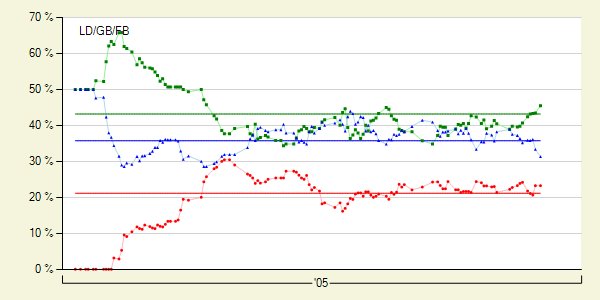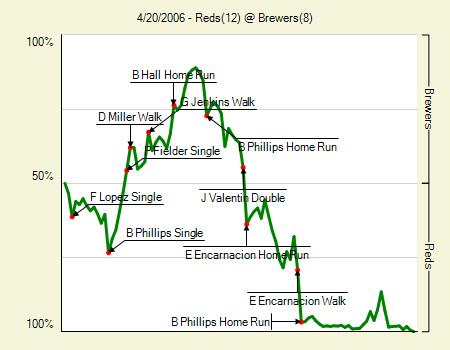With the start of the Brewer's 2006 season only hours away, I thought it would be interesting to post some of my Brewer player predictions I've made using several of the more advanced statistical metrics out there. You can find some discussion of these predictions at brewerfan.net
here. I also included some of this information in the March edition of the
WOAH SOLVDD Brewerfan.net audio show.
PITCHERSMetric Toolbox:FIP: Fielding Independent Pitching tries cut out the effects of defense and luck from a pitcher’s ERA. Equation is:
 xFIP:
xFIP: Similar to FIP except HR is normalized using the pitcher’s FB rate and adjusted for home park.
BABIP: Batting Average of Balls in Play; The number of batted balls that safely falls in for a hit (not including home runs). Much of the variance in a pitcher’s BABIP is a result of the defense behind him and luck.
LOB%: Percentage of batters a pitcher leaves on base.
ExLOB%: Expected LOB%, based on xFIP. The exact equation is:
 Derrick Turnbow Prediction: ERA of 3.25 in 2006
Derrick Turnbow Prediction: ERA of 3.25 in 2006 2005 Stats:
ERA: 1.74
FIP: 3.18
xFIP: 3.40
BABIP: .259
LOB%: 88.1%
ExLOB%: 74.8%
Notes: Turnbow's BABIP was a little low (compared to team BABIP of about .300) but his nice slider might be the reason why. His LOB% from 2005 is unsustainable, however. He Would have had about a 3.0 ERA with his expected LOB%.
Dave BushPrediction: Will be a solid #4/#5 pitcher Bush has a slightly below average K rate but, like Sheets, has a very low walk rate. Out of the 344 active pitchers with at least 200 innings pitched, Bush has the 16th lowest walk rate, at 2.08 BB/9. For comparison, Sheets is ranked 9th at 2.0 BB/9.
2005 Stats:
ERA: 4.49
FIP: 4.79
xFIP: 4.71
Notes: Last year’s FIP has an NL equivalent of about 4.40. Has a 4.15 ERA in 2 seasons in the American league (NL equivalent of 3.75). Only 26, so has a lot of time to improve.
Chris CapuanoPrediction: ERA of 4.25 in 20062005 Stats:
ERA: 3.99
FIP: 4.65
xFIP: 4.69
LOB%: 77.3%
exLOB%: 70.5%
Notes:Capuano improved his HR rate from 2004 (to league average) but his K/BB was actually worse. Furthermore his 18-12 record last year was primarily a result of great run support and good luck.
Capuano had the 8th highest LOB% among qualified pitchers but did have his pickoffs to help raise that number. Adjusting for his pickoffs, Capuano's LOB% becomes 72.9%. That's still 2.5% above league average, which translates into about 6 extra earned runs and an ERA of 4.23. That's about where I see him for 2006, along with a .500 win/loss record.
In Capuano's defense, he trailed off towards the end of the year, and a heavy workload may have been the culprit. While his K rate
increased (scroll down a bit), so did his walk and HR rate (primarily because he was giving up more fly balls). 219 innings may have simply been 40 innings too many him last year. With a healthy Sheets, Capuano may see his innings reduced, which might allow his numbers stay strong through September.
HITTERSMetric Toolbox:prOPS:
Predicted OPS tries to cut through the luck of a batter’s OPS; Uses 6 main factors:
K/PA, BB/PA, HBP/PA, HR/AB, GB/FB, LD%
Bill HallPrediction: .800 OPS 2005 StatsOPS: .837
prOPS : .753
Notes: As I’ve
pointed out before, Hall had the 4th highest prOPS over performance in 05’ and the 13th highest since 02’. Most if the difference was from the 60 point difference between his SLG and prSLG
Why be optimistic about Hall at all?Hall’s approach looked much improved in 2005. He seemed more patient and selective at the plate. This seems to be supported by his pitches/PA numbers
Year Pitches/PA
2004: 3.80
2005: 4.16
3.8 pitches/PA is above average; 4.16 is crazy patient. He also reduced his strikeouts while increasing his walk rate slightly. Furthermore, at only 26 years and with last year being the first time Hall has had any consistent playing time in majors, it would be unfair to not have some optimism for Hall
Geoff JenkinsPrediction: Will continue to be valuable defensively•
"Fielding Bible" by John Dewan has the Brewers having given up the most singles in front of the RF in 05', yet has Geoff Jenkins ranked as the best RFer in the NL last year. Perhaps Jenkins playing deep saves a lot of extra base hits?
• Dave Pinto of
Baseballmusings.com created a defensive metric called
PMR. Jenkins saved
6 runs over average last year, according to it.
• One of the
highest hold% in last 3 years.
• Has thrown out 5 runners at home in the last 3 years. Again, he was
one of the best in the league at doing so.
J.J HardyPrediction: Will have a break out yearOPS: .711
prOPS: .748
Second Half: Normally its statistical folly to ignore bad parts of a player’s season, but Hardy is a different matter. After being benched for 4 games in late May, Hardy completely changed his approach at the plate. He decided to be more aggressive, like he was in the minors. The change was dramatic:

Before May 24th, he had an excellent contact rate and walk rate, but his power was non-existent. After changing his approach, his contact and walk rate lowered but his power numbers increased dramatically. These changes can be further illustrated by tracking his BIP types as the year progressed (complements of
fangraphs.com)


The increase in power was no fluke. More fly balls and more line drives equal more power. While Hardy had to concede less contact with his more aggressive approach, he more than made up for it in just about every other area. If Hardy can continue in 2006 where he left off in 2005, he's going to have a phenomenal year.










